Abstract
Based on our previous transgenic mice results, which strongly suggested that separate cell-specific cis-acting elements of the mouse pro-alpha 1(I) collagen promoter control the activity of the gene in different type I collagen-producing cells, we attempted to delineate a short segment in this promoter that could direct high-level expression selectively in osteoblasts. By generating transgenic mice harboring various fragments of the promoter, we identified a 117-bp segment (-1656 to -1540) that is a minimal sequence able to confer high-level expression of a lacZ reporter gene selectively in osteoblasts when cloned upstream of the proximal 220-bp pro-alpha 1(I) promoter. This 220-bp promoter by itself was inactive in transgenic mice and unable to direct osteoblast-specific expression. The 117-bp enhancer segment contained two sequences that appeared to have different functions. The A sequence (-1656 to -1628) was required to obtain expression of the lacZ gene in osteoblasts, whereas the C sequence (-1575 to -1540) was essential to obtain consistent and high-level expression of the lacZ gene in osteoblasts. Gel shift assays showed that the A sequence bound a nuclear protein present only in osteoblastic cells. A mutation in the A segment that abolished the binding of this osteoblast-specific protein also abolished lacZ expression in osteoblasts of transgenic mice.
Full text
PDF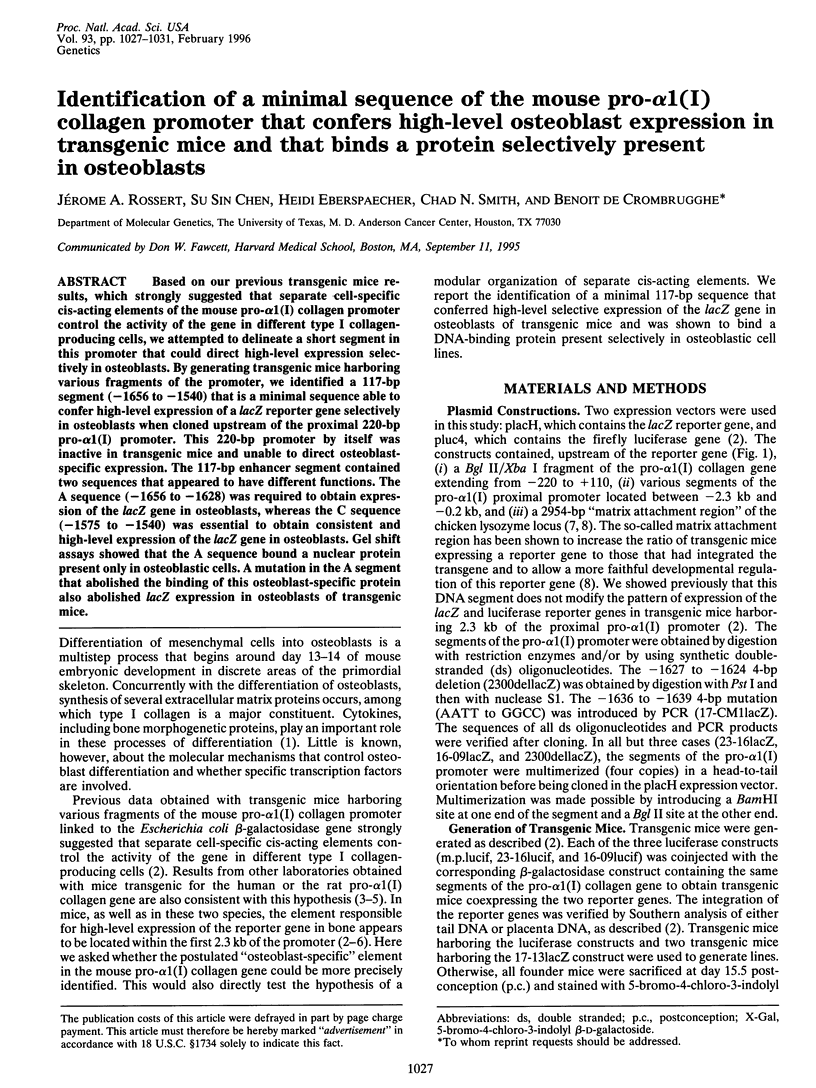
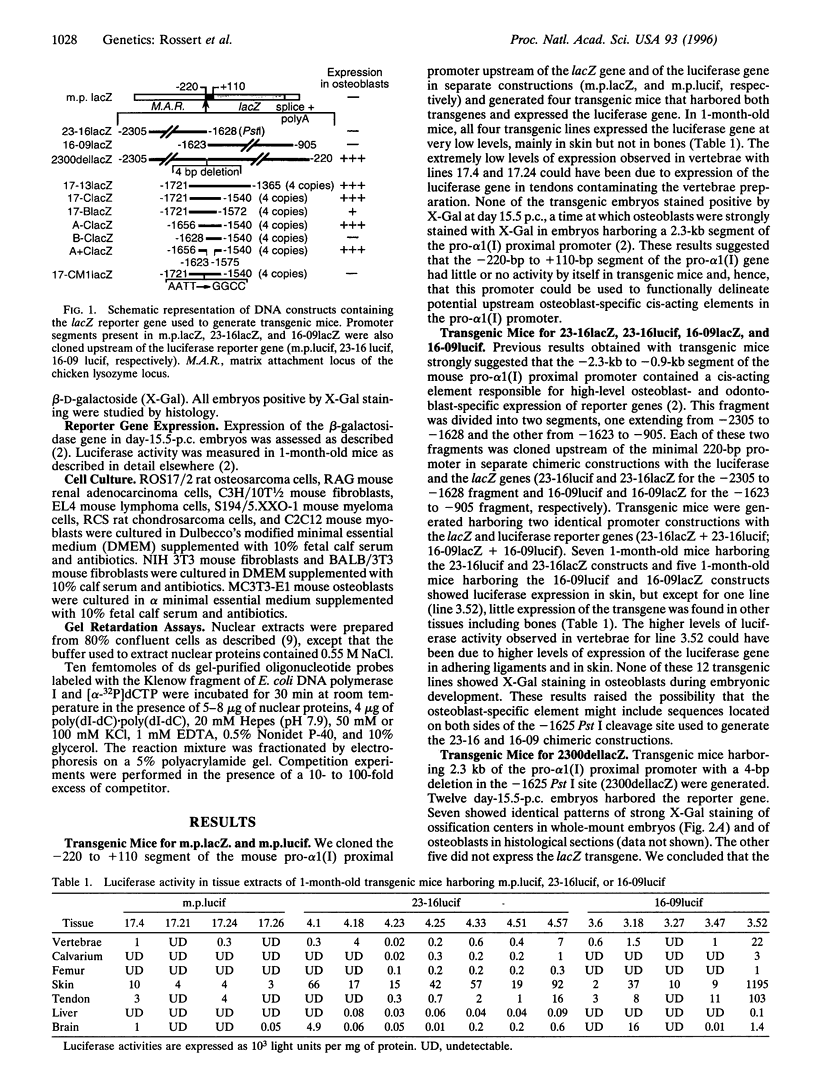
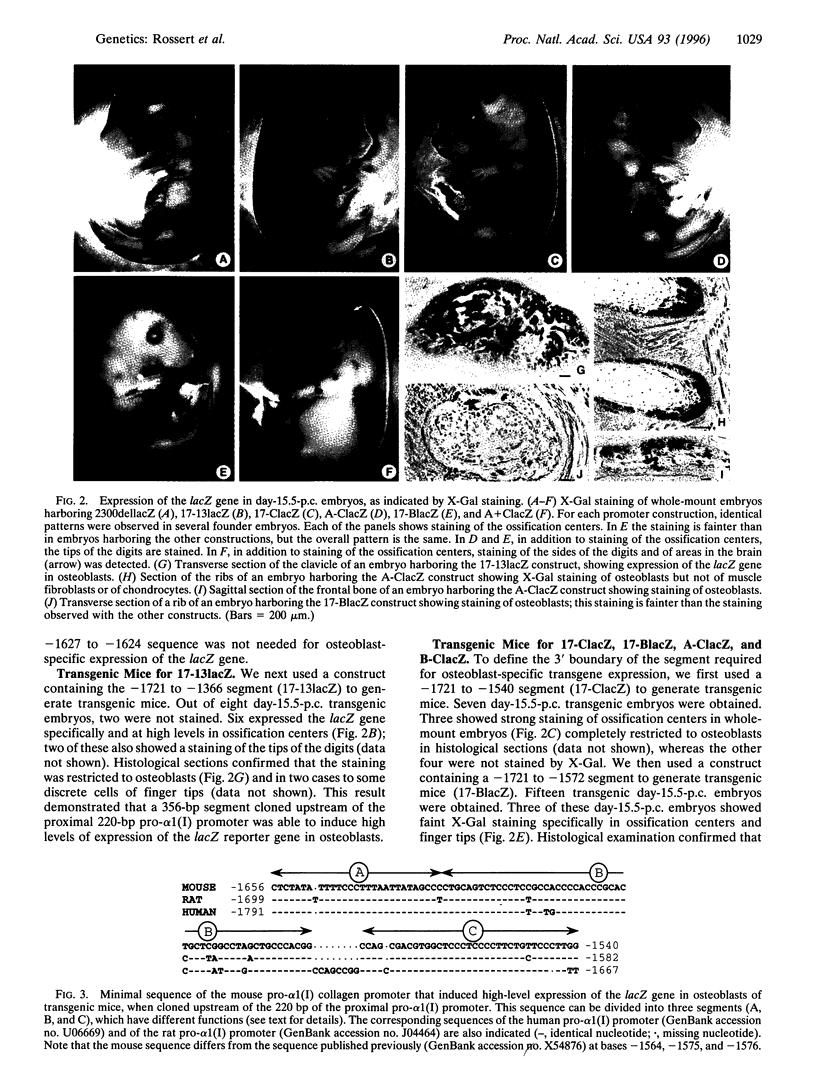
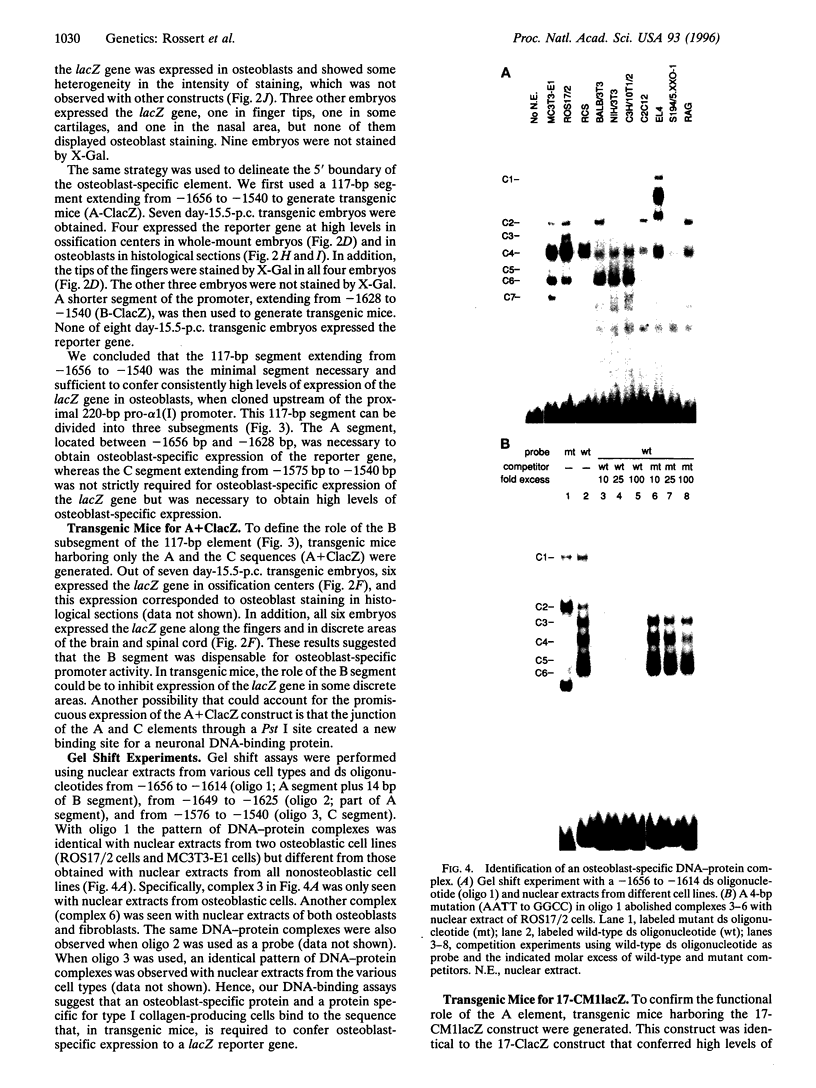
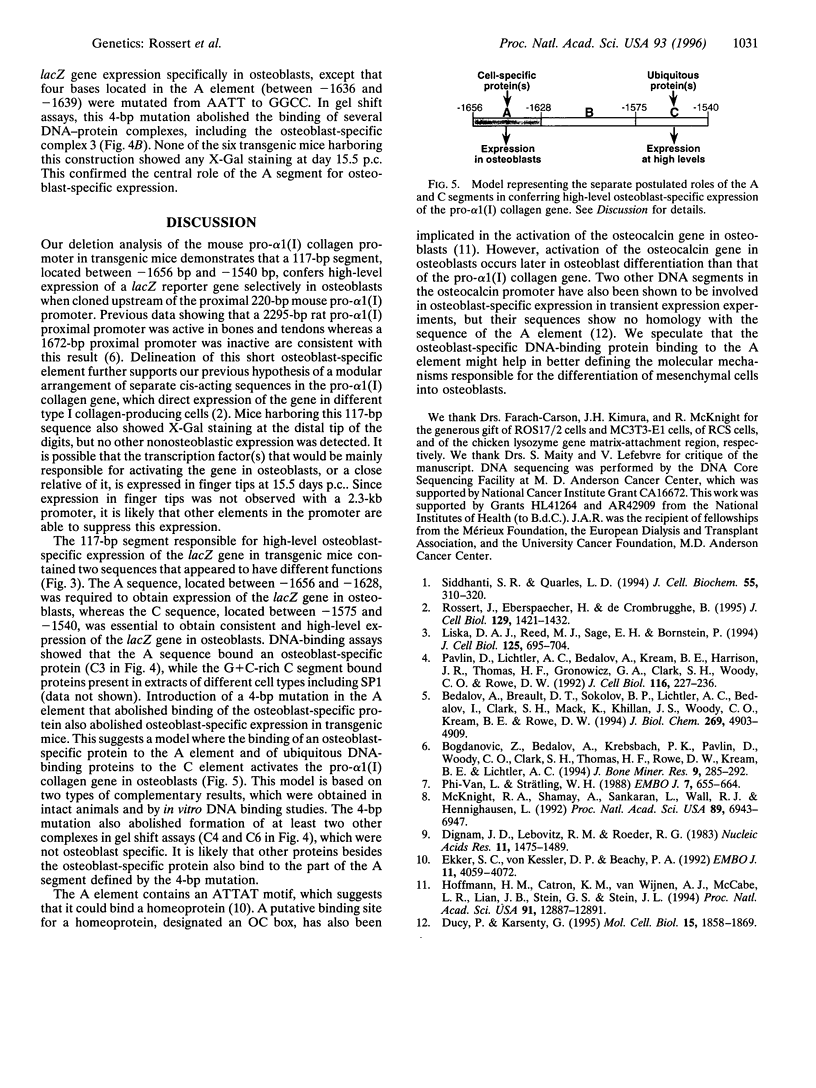
Images in this article
Selected References
These references are in PubMed. This may not be the complete list of references from this article.
- Bedalov A., Breault D. T., Sokolov B. P., Lichtler A. C., Bedalov I., Clark S. H., Mack K., Khillan J. S., Woody C. O., Kream B. E. Regulation of the alpha 1(I) collagen promoter in vascular smooth muscle cells. Comparison with other alpha 1(I) collagen-producing cells in transgenic animals and cultured cells. J Biol Chem. 1994 Feb 18;269(7):4903–4909. [PubMed] [Google Scholar]
- Bogdanovic Z., Bedalov A., Krebsbach P. H., Pavlin D., Woody C. O., Clark S. H., Thomas H. F., Rowe D. W., Kream B. E., Lichtler A. C. Upstream regulatory elements necessary for expression of the rat COL1A1 promoter in transgenic mice. J Bone Miner Res. 1994 Feb;9(2):285–292. doi: 10.1002/jbmr.5650090218. [DOI] [PubMed] [Google Scholar]
- Dignam J. D., Lebovitz R. M., Roeder R. G. Accurate transcription initiation by RNA polymerase II in a soluble extract from isolated mammalian nuclei. Nucleic Acids Res. 1983 Mar 11;11(5):1475–1489. doi: 10.1093/nar/11.5.1475. [DOI] [PMC free article] [PubMed] [Google Scholar]
- Ducy P., Karsenty G. Two distinct osteoblast-specific cis-acting elements control expression of a mouse osteocalcin gene. Mol Cell Biol. 1995 Apr;15(4):1858–1869. doi: 10.1128/mcb.15.4.1858. [DOI] [PMC free article] [PubMed] [Google Scholar]
- Ekker S. C., von Kessler D. P., Beachy P. A. Differential DNA sequence recognition is a determinant of specificity in homeotic gene action. EMBO J. 1992 Nov;11(11):4059–4072. doi: 10.1002/j.1460-2075.1992.tb05499.x. [DOI] [PMC free article] [PubMed] [Google Scholar]
- Hoffmann H. M., Catron K. M., van Wijnen A. J., McCabe L. R., Lian J. B., Stein G. S., Stein J. L. Transcriptional control of the tissue-specific, developmentally regulated osteocalcin gene requires a binding motif for the Msx family of homeodomain proteins. Proc Natl Acad Sci U S A. 1994 Dec 20;91(26):12887–12891. doi: 10.1073/pnas.91.26.12887. [DOI] [PMC free article] [PubMed] [Google Scholar]
- Liska D. J., Reed M. J., Sage E. H., Bornstein P. Cell-specific expression of alpha 1(I) collagen-hGH minigenes in transgenic mice. J Cell Biol. 1994 May;125(3):695–704. doi: 10.1083/jcb.125.3.695. [DOI] [PMC free article] [PubMed] [Google Scholar]
- Loc P. V., Strätling W. H. The matrix attachment regions of the chicken lysozyme gene co-map with the boundaries of the chromatin domain. EMBO J. 1988 Mar;7(3):655–664. doi: 10.1002/j.1460-2075.1988.tb02860.x. [DOI] [PMC free article] [PubMed] [Google Scholar]
- McKnight R. A., Shamay A., Sankaran L., Wall R. J., Hennighausen L. Matrix-attachment regions can impart position-independent regulation of a tissue-specific gene in transgenic mice. Proc Natl Acad Sci U S A. 1992 Aug 1;89(15):6943–6947. doi: 10.1073/pnas.89.15.6943. [DOI] [PMC free article] [PubMed] [Google Scholar]
- Pavlin D., Lichtler A. C., Bedalov A., Kream B. E., Harrison J. R., Thomas H. F., Gronowicz G. A., Clark S. H., Woody C. O., Rowe D. W. Differential utilization of regulatory domains within the alpha 1(I) collagen promoter in osseous and fibroblastic cells. J Cell Biol. 1992 Jan;116(1):227–236. doi: 10.1083/jcb.116.1.227. [DOI] [PMC free article] [PubMed] [Google Scholar]
- Rossert J., Eberspaecher H., de Crombrugghe B. Separate cis-acting DNA elements of the mouse pro-alpha 1(I) collagen promoter direct expression of reporter genes to different type I collagen-producing cells in transgenic mice. J Cell Biol. 1995 Jun;129(5):1421–1432. doi: 10.1083/jcb.129.5.1421. [DOI] [PMC free article] [PubMed] [Google Scholar]
- Siddhanti S. R., Quarles L. D. Molecular to pharmacologic control of osteoblast proliferation and differentiation. J Cell Biochem. 1994 Jul;55(3):310–320. doi: 10.1002/jcb.240550307. [DOI] [PubMed] [Google Scholar]






